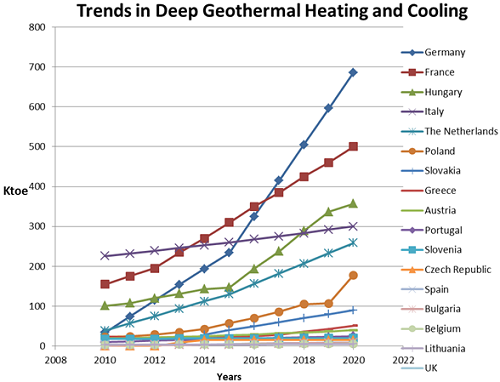In June 2011 we participated in the preparation of the project GEO-DH for European Commission´s (EC) funding scheme of the CIP-IEE (Competitiveness and Innovation Framework Programme - Intelligent Energy Europe). The project with the full title “Promote Geothermal District Heating Systems in Europe” was proposed by EGEC and other nine participants. We are happy to announce that this interesting project has been positively evaluated by the EC. Once the negotiation will be concluded, the project will start for a period of 30 months.
The project is aimed at stimulation of the use of geothermal energy sources for heating purposes. The main driver is to consequently replace the use of fossil fuels by district heating (DH) by 2020. Geothermania presents this project in four simple questions:
- Why is this project important for Europe?
The sector of Heating and cooling is an important player responsible for approximately 50% of total European final energy consumption as well as a large part of greenhouse gas emissions. District heating has a long tradition, especially in the Nordic countries and in those countries of Central and Eastern Europe with formerly centrally planned economies. In general, the use of district heating systems is stated as economically feasible and ecologically preferable for the broad introduction of low-enthalpy geothermal sources.
Many district heating systems in Europe already use renewable energy sources in their energy mix. At present around 14% of the heat for district heating in Europe is derived from renewable sources (biomass, geothermal, solar) and waste, both directly (e.g. boilers) and indirectly (e.g. co-generation). However, there is a greater potential to expand the use of renewable sources since many of the systems operating especially in Central and Eastern Europe are generally in bad conditions. Such systems operate inefficiently with cumulative heat losses in generation, transportation, distribution and end-use from 35 % to 77 %!
- What are the objectives of GEO-DH?
Worldwide, utilization of geothermal technology in DH is an efficient and environmental friendly approach. Geothermal application in DH will result in significant savings of primary energy resources and ensuring security of supply. Therefore the most important objective of the project is to significantly increase the number of geothermal DH schemes. This can be reached by encouraging district heating scheme owners to improve and modernise their systems and to increase the share of geothermal in district heating.
Another ambitious target is to identify current barriers in order to promote the best circumstances for policy makers. There are several obstacles to the development of geothermal resources, and especially geothermal DH, which are characteristic of the transition of countries in Europe, more specifically Central and Eastern Europe, such as unrealistically low energy prices, weak financial and institutional infrastructure. There is a stated the need for market price reform, new financing mechanisms, and technology transfer to promote geothermal development, as well as the importance of new pilot projects.
- How will be the aims fulfilled?
The GEO-DH consortium participants come from the following countries will be participating in this project Belgium, Bulgaria, Denmark, France, Hungary, Italy, Netherlands, Poland, Slovakia and Slovenia. Moreover, project´s activities and aims cover countries with support from EGEC members also another 14 countries. During a of 30 months, the GEO-DH project will focus on increasing the market penetration of geothermal district heating systems in several Member States, and especially in Eastern and Central Europe. This region is rich in medium and low enthalpy geothermal resources which are located in several sedimentary basins, such as Carpathian basin, Pannonian Basin and Podhale basin.
In order to identify barriers and the specifics of national situations necessary to exchange information, on costs and the market penetration, evaluating national and local regulatory framework. Legal and financial recommendations will be drafted to accelerate market penetration of this technology. The sharing of best practice and technologies among European Countries will be achieved through the arrangement of seminars focusing on audiences such as developers, municipalities and energy service companies. The targeted seminars will address issues such as evaluation of resources and widening existing resource bases, energy conversion, operation and control, connection to local power and district heating infrastructures, as well as organizational issues and other related topics.
- What is an expected impact of the GEO-DH project?
GEO-DH project aims at several ambitious results:
- Understanding of the technologies involved within geothermal district heating and cooling
- Awareness of the current situation and recommendations for raising regulatory market barriers
- Improving national and local regulatory framework and increasing national market penetration of geothermal energy.
- Transfer of best practices and examples of successful applications to national and local authorities and the public sectors of the regions
- Training energy officers, developers and installers, on matters concerning geothermal DH technologies
- Increasing awareness among key professional groups on the potential applications and benefits, of direct heating and cooling with geothermal energy.
In order to achieve stated goals, a number of reports will be prepared with regulatory and financial issues. In addition participants will organise seminars and workshops which will communicate the potential applications and benefits of geothermal energy.
In conclusion, it is of extreme importance to create all the necessary boundary conditions to make sure that renewable heating and cooling from geothermal sources can be used in an optimal way. And Geothermania believes that GEO-DH project is a suitable tool for this challenge.




